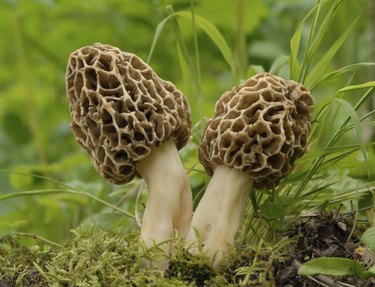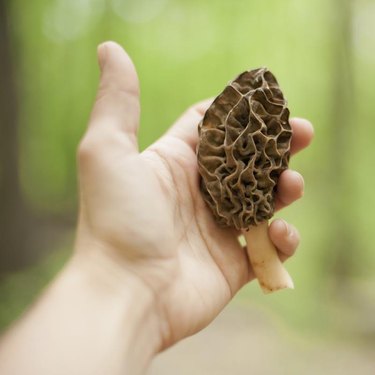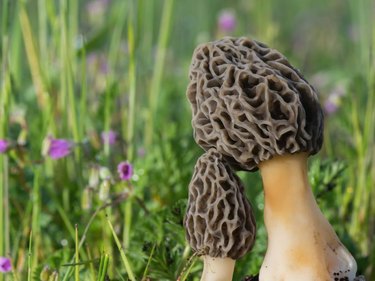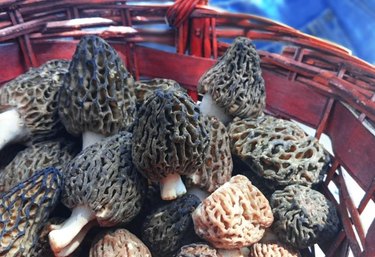Don't count on cultivating morels in your garden! This spongy critter is one of the few plants that cannot be successfully cultivated. But you can hardly blame King Morel for putting on airs, as it's the single most popular wild mushroom on the continent and, according to throngs of admirers, the best tasting.
The truth is, hunting for morels in fields and forests brings out the hunter/gatherer instinct in all of us. And the deliciously earthy flavor of morels -- a meaty, nutlike taste -- rewards your efforts. If you are new to the pleasure, here are all the tips you need to get started.
Video of the Day
Video of the Day

More About the Morel
Imagine a tiny Christmas tree made of natural sponge and you've got a good idea what a morel mushroom looks like. Given it's eccentric appearance, the morel is one of the safest mushrooms to pick in the wild, without many of the poisonous look-alikes that the French refer to as "false friends."
Almost anyone who has seen morels can pick one out of a line-up. Look for a thick, sponge-like finger pushing through the layer of dead forest leaves in the springtime. Size doesn't matter -- the protuberance can be anywhere from 1 to 6 inches.
Double-check your find by inspecting the stem of the mushroom: morels are always hollow, and the stem attaches to the base of the cap. The common morel (Morchella esculentoides) has a honeycombed cap with yellowish ridges and pits, while the ridges of the black morel (Morchella angusticeps) are, unsurprisingly, black or dark brown.
Warning
Keep an eye out for imposters just in case. If the stem of the mushroom is dense rather than hollow, the cap is wrinkled rather than pitted, or the bottom of the cap hangs loose from the stem, don't add it to your basket. You may have found the false morel -- mildly toxic -- or the half-free morel that can cause indigestion.

Finding the Morel Moment
What better season than spring to take off into the woodlands on a mushroom hunt? When the daytime temperatures hit 60 to 80 degrees Fahrenheit and nights don't dip below 40 degrees -- that's the morel moment. Since trees are just starting to leaf, the sunlight is able to splash across the floor of the forest to awaken the morel spores.
Another clue that it's morel time is to look for wildflowers like trillium, Dutchman's breeches, violets or wild strawberries. They all make their appearance about the same time as this super-mushroom.

Morel Mapping
You won't be able to use your GPS to track down wild fungus, and even experienced morel hunters may not be able to offer too many tips. That's why they call it mushroom hunting. But a few tips will help.
Look for black morels in hardwood forests -- you're not likely to find them anywhere else. But, unlike some other wild mushrooms, wild morels do not grow symbiotically with any particular tree, so the presence of oaks or beech or ash is not necessarily a sign of morels-to-come.
Common morels are even more elusive, since they grow in field and floodplane, forest and fence row. Your best bet for navigation is to find dead or dying trees -- elm, ash, sycamore or cottonwood.

The Morel Mosey
If you see an elusive figure out in the woodlands in springtime, slouching along low like Groucho Marx, the odds are it's a morel hunter. You'll want to do the mushroom walk too, crouched over and scanning the ground ahead. You'll be far more likely to recognize the morel shape in silhouette than from above.
Once you find your first morel, hunker down and scour the neighborhood. Remember that morels grow from spores that are wafted on the breeze. If one spore landed just there, at your feet, the odds are that others also landed and found the necessary nutrients in the general area.
Tip
Carry a mesh bag for your morel harvest, not a paper or plastic one. Morels reproduce from tiny spores that fly off the mushroom caps when they are moved. Mesh bags, like the kind that oranges and onions are sold in, work fine, although you can buy "spore bags" at specialty stores.